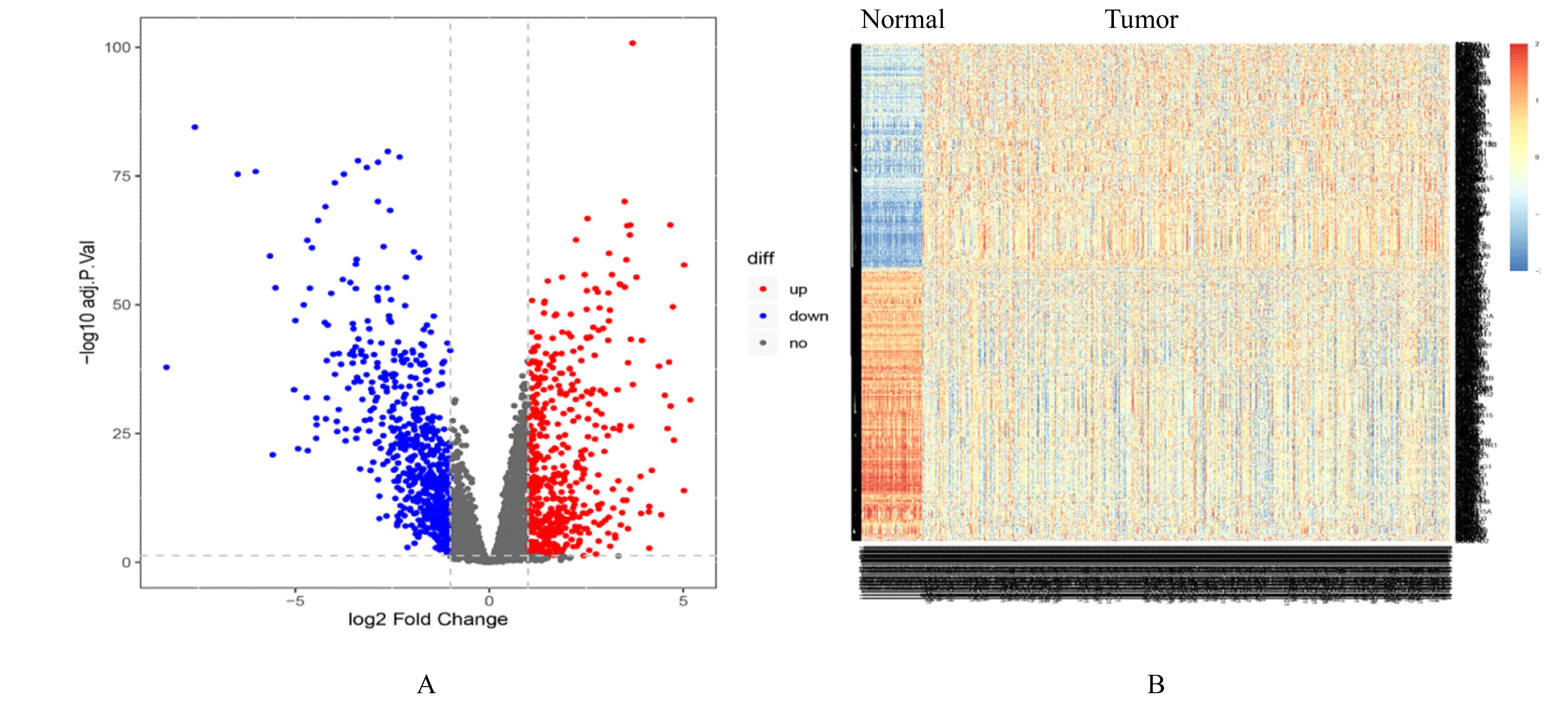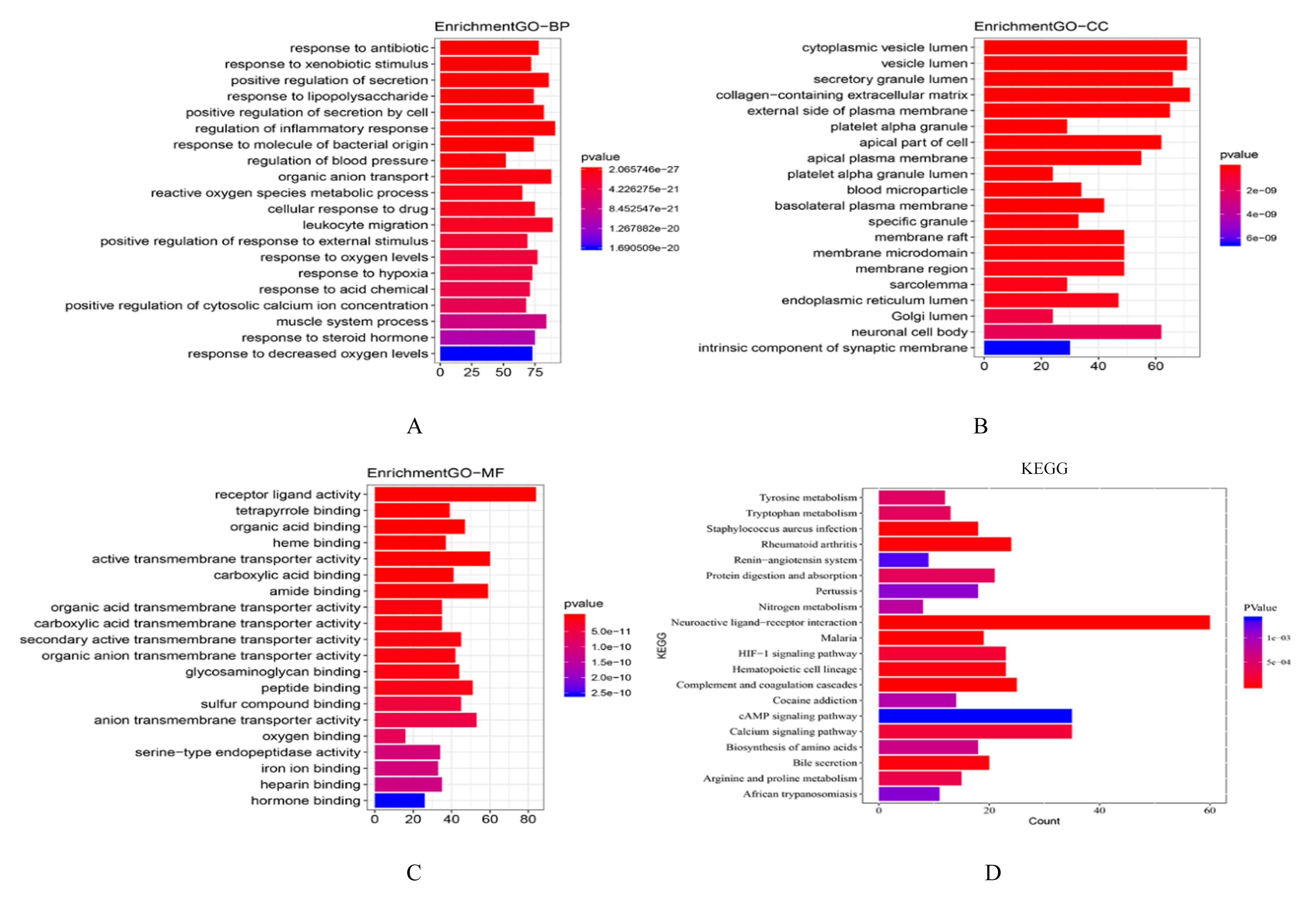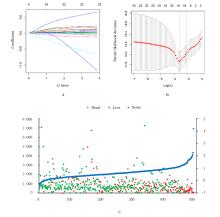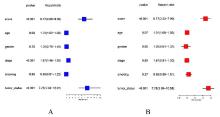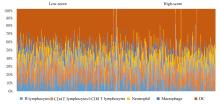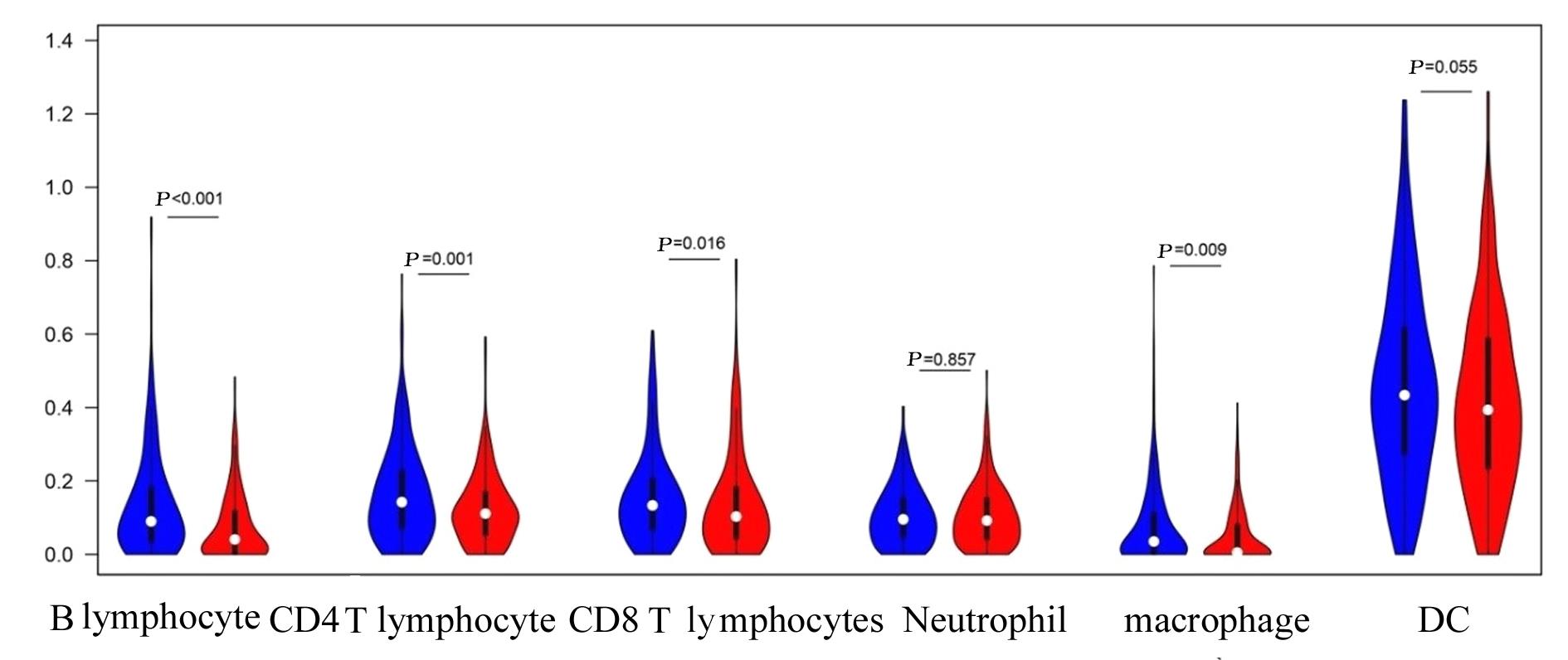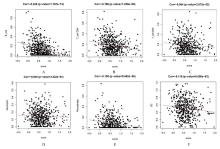Journal of Jilin University(Medicine Edition) ›› 2022, Vol. 48 ›› Issue (6): 1546-1554.doi: 10.13481/j.1671-587X.20220621
• Research in clinical medicine • Previous Articles Next Articles
Establishment and evaluation of prognostic model of lung adenocarcinoma based on lactate metabolism gene
Junjie HOU1,2,Xuguang MI2,Xiaonan LI2,Xiaonan LI2,Ying YANG2,Xiaodan LU2,Yanqiu FANG2,Ningyi JIN1,3( )
)
- 1.Department of Pathophysiology,School of Medical Sciences,Yanbian University,Yanji 133002,China
2.Department of Comprehensive Oncology,Jilin Province People’s Hospital,Changchun 130021,China
3.Laboratory of Molecular Virology and Immunology,Academy of Military Medical Science,Changchun 130122,China
-
Received:2021-12-08Online:2022-11-28Published:2022-12-07 -
Contact:Ningyi JIN E-mail:ningyik@126.com
CLC Number:
- R734.2
Cite this article
Junjie HOU,Xuguang MI,Xiaonan LI,Xiaonan LI,Ying YANG,Xiaodan LU,Yanqiu FANG,Ningyi JIN. Establishment and evaluation of prognostic model of lung adenocarcinoma based on lactate metabolism gene[J].Journal of Jilin University(Medicine Edition), 2022, 48(6): 1546-1554.
share this article
| 1 | SIEGEL R L, MILLER K D, FUCHS H E, et al. Cancer Statistics, 2021[J]. CA Cancer J Clin, 2021, 71(1): 7-33. |
| 2 | BRAY F, FERLAY J, SOERJOMATARAM I, et al. Global cancer statistics 2018: GLOBOCAN estimates of incidence and mortality worldwide for 36 cancers in 185 countries[J].CA Cancer J Clin,2018,68(6):394-424. |
| 3 | LÖFLING L, BAHMANYAR S, KIELER H, et al. Temporal trends in lung cancer survival: a population-based study[J]. Acta Oncol, 2022, 61(5): 625-631. |
| 4 | ZHANG C, HE Z, CHENG L, et al. Investigation of prognostic markers of lung adenocarcinoma based on tumor metabolism-related Genes[J].Front Genet, 2021, 12: 760506. |
| 5 | ŠUTIĆ M, VUKIĆ A, BARANAŠIĆ J, et al. Diagnostic, predictive, and prognostic biomarkers in non-small cell lung cancer (NSCLC) management [J]. J Personal Med, 2021, 11(11): 1102. |
| 6 | IVASHKIV L B. The hypoxia-lactate axis tempers inflammation[J]. Nat Rev Immunol,2020,20(2): 85-86. |
| 7 | CERTO M, TSAI C H, PUCINO V, et al. Lactate modulation of immune responses in inflammatory versus tumour microenvironments[J]. Nat Rev Immunol, 2021, 21(3): 151-161. |
| 8 | ZHANG D, TANG Z, HUANG H, et al. Metabolic regulation of gene expression by histone lactylation[J]. Nature, 2019, 574(7779): 575-580. |
| 9 | FEI X, HU C, WANG X, et al. Construction of a ferroptosis-related long non-coding RNA prognostic signature and competing endogenous RNA Network in lung adenocarcinoma[J]. Front Cell Dev Biol, 2021,8(9): 751490. |
| 10 | LI B, SEVERSON E, PIGNON J C, et al. Comprehensive analyses of tumor immunity: implications for cancer immunotherapy[J]. Genome Biol, 2016, 17(1): 174. |
| 11 | FAUBERT B, LI K Y, CAI L, et al. Lactate metabolism in human lung tumors[J]. Cell, 2017, 171(2): 358-371. |
| 12 | YU C, HOU L, CUI H, et al. LDHA upregulation independently predicts poor survival in lung adenocarcinoma, but not in lung squamous cell carcinoma[J]. Future Oncol, 2018, 14(24): 2483-2492. |
| 13 | LIU L, YANG C, SHEN J, et al. GABRA3 promotes lymphatic metastasis in lung adenocarcinoma by mediating upregulation of matrix metalloproteinases[J]. Oncotarget, 2016, 7(22): 32341-32350. |
| 14 | HAN M, WANG B, ZHU M, et al. C1QTNF6 as a novel biomarker regulates cellular behaviors in A549 cells and exacerbates the outcome of lung adenocarcinoma patients[J]. In Vitro Cell Dev Biol Anim, 2019, 55(8): 614-621. |
| 15 | LI Y J, YANG Z, WANG Y Y, et al. Long noncoding RNA ZNF667-AS1 reduces tumor invasion and metastasis in cervical cancer by counteracting microRNA-93-3p-dependent PEG3 downregulation[J]. Mol Oncol, 2019, 13(11): 2375-2392. |
| 16 | GIATROMANOLAKI A, HARRIS A L, KOUKOURAKIS M I. The prognostic and therapeutic implications of distinct patterns of argininosuccinate synthase 1 (ASS1) and arginase-2 (ARG2) expression by cancer cells and tumor stroma in non-small-cell lung cancer[J]. Cancer Metabol, 2021, 9(1): 28. |
| 17 | SUN J, XIE T, JAMAL M, et al. CLEC3B as a potential diagnostic and prognostic biomarker in lung cancer and association with the immune microenvironment[J].Cancer Cell Int,2020,1(20): 106. |
| 18 | YE D, QU J, WANG J, et al. A new clinical nomogram from the TCGA database to predict the prognosis of hepatocellular carcinoma[J]. Front Oncol, 2021, 11: 698980. |
| 19 | MULTHOFF G, VAUPEL P. Lactate-avid regulatory T cells: metabolic plasticity controls immunosuppression in tumour microenvironment[J].STTT,2021,6(1): 171. |
| [1] | Wei CHEN,Nan SHEN,Wanna HAN,Yanli XI,Kuang REN,Lianhai JIN,Na XU. Effect of adapters of Toll-like receptor 4 on M2 polarization of macrophages induced by lactate and its mechanism [J]. Journal of Jilin University(Medicine Edition), 2022, 48(5): 1190-1199. |
| [2] | Xiaoyan LI,Wei ZHANG,Jie HE. Promotion effect of REG1A on proliferation and migration of lung adenocarcinoma cells by regulating Wnt/β-catenin signaling pathway [J]. Journal of Jilin University(Medicine Edition), 2022, 48(2): 444-453. |
| [3] | Shuzhen LI,Yajie CAO,Haiying GENG,Zengxiaorui CAI,Chunmei DAI,Youfeng WEN,Ning LI. Bioinformatics analysis based on expression level of HMMR in lung adenocarcinoma tissue and its impact on prognosis of LUAD patients [J]. Journal of Jilin University(Medicine Edition), 2021, 47(6): 1502-1509. |
| [4] | GUO Weiwei, QIN Yue, YANG Haibo, MI Zhanhu. Promotion effect of LncRNA MALAT1 on osteogenic differentiation of adipose-derived mesenchymal stem cells through miR-34c/SATB2 axis [J]. Journal of Jilin University(Medicine Edition), 2020, 46(05): 963-971. |
| [5] | WANG Dan, LIAO Dan, LI Hong, XIONG Liqiu, WU Ying, DONG Ying, GAI Xiaodong. Expressions of plasmacytoid dendritic cells and Foxp3+ regulatory T cells in colorectal cancer tissue and their significances [J]. Journal of Jilin University(Medicine Edition), 2020, 46(04): 834-838. |
| [6] | FENG Lei, ZHANG Hante, LI Xiang, MENG Fanping, LI Yan. Promotion effect of IL-4 and estradiol on growth of breast cancer cells in mice and its mechanism [J]. Journal of Jilin University(Medicine Edition), 2020, 46(03): 536-542. |
| [7] | ZHAO Min, JIN Xin, DI Xin, TIAN Chang, LIU Jiaying, CONG Shan, WANG Ke. Invasive mucinous adenocarcinoma of lung: A case report and literature review [J]. Journal of Jilin University(Medicine Edition), 2020, 46(03): 634-638. |
| [8] | FANG Hui, YANG Hongyu, MA Xuzhe, CHEN Lisong, GAI Xiaodong, LI Chun. Effects of FOXP3 on cell proliferation and chemosensitivity to cisplatin in lung adenocarcinoma cells [J]. Journal of Jilin University(Medicine Edition), 2019, 45(06): 1261-1266. |
| [9] | ZOU Jun, CHEN Bing, FANG Minghui, HU Zheng. Establishment and identification of humanized mouse models with human immune system and allogeneic human melanoma growth [J]. Journal of Jilin University(Medicine Edition), 2019, 45(03): 718-724. |
| [10] | SUN Xiaoxu, WANG Tu, CUI Haipeng, LIU Kai, GAO Haicheng, ZHAO Juan. Effects of urantide on serum calcium, blood lipids and indexes of myocardial enzymes in rats with atherosclerosis [J]. Journal of Jilin University(Medicine Edition), 2019, 45(02): 331-335. |
| [11] | YANG Yi, BAO Kangda, ZHOU Yanbing, YUAN Chao, LI Yong, LIU Xiaoming, XU Jinrui. Regulation of Wnt5a in apoptosis of human lung adenocarcinoma A549 cells and its mechanism [J]. Journal of Jilin University Medicine Edition, 2018, 44(02): 229-234. |
| [12] | WANG Chaoyi, WANG Qiang, ZHENG Yueyong, LI Cong, GUO Dunwei, TANG Hua. Effect of follistatin on skeletal muscle wasting of cancer cachexia mice and its mechanism [J]. Journal of Jilin University Medicine Edition, 2016, 42(04): 653-658. |
| [13] | ZHANG Yunping, LI Yangkang, LIU Chenyang, ZHU Jiahui, WU Renhua. Application of 9.4 T 1H-MR spectroscopy in determination of lactate in brain of mice with early acute hypoxia-ischeia injury and its significance [J]. Journal of Jilin University Medicine Edition, 2016, 42(04): 690-693. |
| [14] | CAO Xin-mei,ZHANG Dai-quan,WANG Xu,XIA Ji-yi,HUANG Li,GAO Yan. Effect of C-erbB-2 shRNA on chemosensitivity of mouse lung adenocarcinoma cells and its mechanism [J]. Journal of Jilin University Medicine Edition, 2014, 40(04): 777-781. |
| [15] | LIU Xiao-dan,GAO Yu-xian, REN Jing,ZHANG Min-min,YAN Chao-ying. Application value of urinary lactate/creatinine ratio in prognosis evaluation of neonatal asphyxia [J]. Journal of Jilin University Medicine Edition, 2014, 40(03): 655-658. |
|

